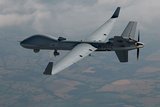Ultra Electronics tri-fuel engine flies SPEAR UAS
Brock Technologies, Incorporated, a fast emerging rapid unmanned systems solutions provider, has teamed with Ultra Electronics Precision Air Systems, a leading aerospace and defense systems company, to integrate an impressive and capable propulsion technology, the DF-70. The DF-70 is a heavy fuel, fuel injected, internal combustion engine that is capable of operating on different fuels for extended periods of time.
After a short period of very successful ground based testing, the Ultra Electronics' DF-70 was integrated onto the Brock Technologies' SPEAR Unmanned Aircraft System (UAS) for flight testing. The SPEAR UAS features an independently shifting wing and fuselage pod enabling it to be reconfigured to hold a wide variety of payloads without the need for ballast. In early 2010, the SPEAR flew in an electric configuration for over 1 hour while carrying 14 pounds of payload and drawing a nominal 375W of power. Now, the SPEAR has been fitted with the DF-70 3HP heavy fuel engine enabling it to achieve flight times longer than any other UAS in its class. During the maiden flight with the DF-70, the SPEAR weighed in at 28.95 lbs and demonstrated cruising speeds of 36 kts and mild dashes at just over half power of 62kts. Keith Brock, Vice President of Brock Technologies, Inc. said, "Each flight we are slowly expanding the SPEAR's flight envelope as we unleash the power of the DF-70 and work our way up to full power and full endurance." Keith is known for his UAS designs with his past employers such as the BAE( formally Advanced Ceramics Research) Silver Fox Block A, Silver Fox Block B, Manta Block A, and Raytheon Missile System's Cobra UAS. "It is a good feeling to improve upon capabilities of past designs in the same class." he adds.
During the maiden flight, the DF-70 engine utilized Jet-A fuel. However, the DF-70 is capable of utilizing other fuels such as JP-8, Diesel or Mo-Gas. Keith described the engine as a "powerful beast at full throttle with an unmatched low, quiet idle" that will give the Brock SPEAR high speed dash capability, a reduced noise signature for ISR and a potential hand launched capability reducing the logistical footprint of other systems with catapult launchers.
Brock sees real opportunities for the DF-70 equipped SPEAR in the currently small but growing numbers of civil applications such as firefighting, costal, pipeline and power line monitoring where a human observer would be at risk or too cost prohibitive for the operation. Further advantages can be seen with police observation of civil disturbances, crime scenes, and reconnaissance support in natural disasters.
The modular construction and adjustable wing position of the Brock SPEAR and low development risk also make this platform suitable for very fast configuration changes for different mass payloads. The new addition of the DF-70 to the SPEAR permit can increase in sensor payload and longer flight times, making this system a perfect match for the military and other UAS applications.
"Working with Ultra Electronics on this project has been amazing." Keith says. "You can see the innovative approach in their product and as a result, Ultra has provided the market with a highly reliable engine. Their product's quality and company's support has enabled us to have nothing but success."
Source: Brock Technologies
More from Uncrewed Vehicles
-
![What's next for the Pentagon after the Replicator programme?]()
What's next for the Pentagon after the Replicator programme?
Although the Replicator initiative has made several accomplishments, there are still multiple gaps to plug across the US Department of Defense (DoD) and its services.
-
![Cummings Aerospace showcases Hellhound loitering munition designed for US Army’s LASSO programme (video)]()
Cummings Aerospace showcases Hellhound loitering munition designed for US Army’s LASSO programme (video)
Cummings Aerospace presented its turbojet-powered Hellhound loitering munition at SOF Week 2025, offering a man-portable solution aligned with the US Army’s LASSO requirements.
-
![SOF Week 2025: PDW unveils attritable FPV drone for SOF operations at scale]()
SOF Week 2025: PDW unveils attritable FPV drone for SOF operations at scale
PDW has revealed its Attritable Multirotor First Person View drone at SOF Week 2025, offering special operations forces a low-cost, rapidly deployable platform for strike and ISR missions, inspired by battlefield lessons from Ukraine.
-
![SOF Week 2025: Teledyne FLIR white paper provides guidance on reusable loitering munitions]()
SOF Week 2025: Teledyne FLIR white paper provides guidance on reusable loitering munitions
Teledyne FLIR is highlighting the emerging requirements for 'recoverable and re-usable' loitering munitions across the contemporary operating environment during this week’s SOF Week conference in Tampa, Florida.
-
![SOF Week 2025: Kraken Technology group debuts K3 Scout USV in North America]()
SOF Week 2025: Kraken Technology group debuts K3 Scout USV in North America
High-performance maritime industry player Kraken Technology Group, based in the UK, has used the SOF Week conference in Tampa, Florida this week to debut its K3 Scout uncrewed surface vessel (USV) to the North American market.
-
![Palladyne AI and Red Cat to demonstrate capabilities for autonomous drone swarms to the US military]()
Palladyne AI and Red Cat to demonstrate capabilities for autonomous drone swarms to the US military
Red Cat and Palladyne AI recently conducted a cross-platform collaborative flight involving three diverse heterogeneous drones.

























